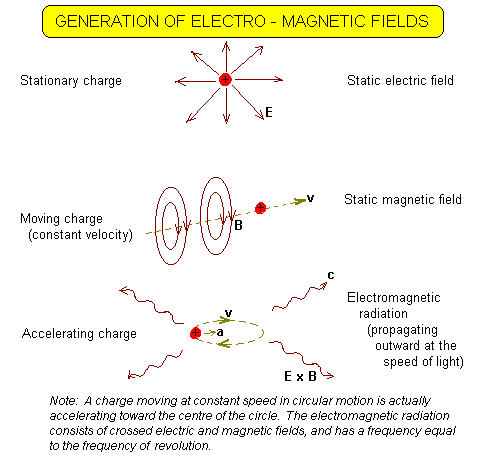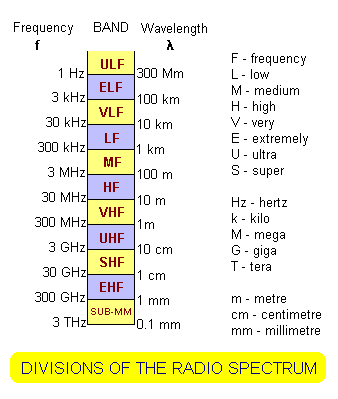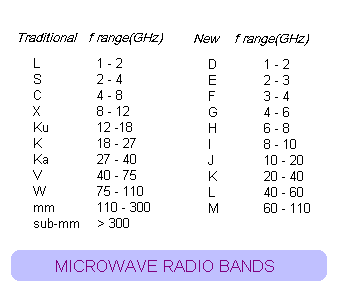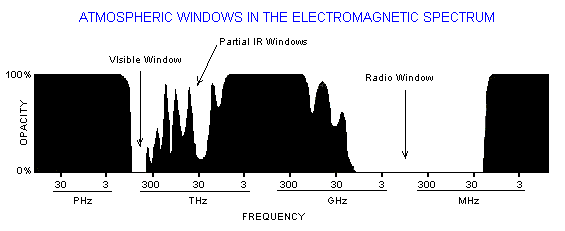
Radio Frequencies for Space Communication
RADIO FREQUENCIES FOR SPACE COMMUNICATION
INTRODUCTION
To be useful satellites and spacecraft must communicate, sometimes to relay communications between two points, sometimes to transmit data they have collected. Although there have been some experiments in optical communications using lasers, most satellite communication is accomplished by radio, one part of the electromagnetic spectrum. Radio frequencies must be shared with terrestrial radio services, and international frequency assignment is essential to avoid interference between all the different uses made of the radio spectrum.
The International Telecommunications Union (ITU) is the global body that assigns radio frequency allocations. In doing this they divide the world into three regions, regions I, II and III. Australian lies in region III. The general frequency assignments may be found at the ITU web site, and Australian allocations may be seen at the ACMA web site. The ITU unfortunately, charges horrendous prices for any of its publications. However, the Australian Communications and Media Authority (ACMA) makes all spectral allocation information available for free download. This includes a book, an attractive wall poster and a simplified spectrum graphic.
This note discusses the frequencies that are used for space communications.
THE ELECTROMAGNETIC SPECTRUM
There are four, and only four known forces in the universe (although the so-called dark energy hints at another). These are, in order of strength, the nuclear strong force, the electromagnetic force, the nuclear weak force and the gravitational force. The two nuclear forces exert their influence over only very very short (nuclear) distances, and apart from holding all matter together do not directly influence us in everyday life. It is gravity and particularly electromagnetism that are of direct concern to us in our daily interactions.
 Gravity springs from the property of matter we call mass, while electromagnetic effects derive from the property we call charge. When a charge is stationary, it has around it an electrostatic field. If it moves with a constant velocity it produces a magnetic field, and when it accelerates or declerates it generates electromagnetic radiation.
Gravity springs from the property of matter we call mass, while electromagnetic effects derive from the property we call charge. When a charge is stationary, it has around it an electrostatic field. If it moves with a constant velocity it produces a magnetic field, and when it accelerates or declerates it generates electromagnetic radiation.
Electromagnetic radiation is a coupled oscillation of electric and magnetic fields that propagates through space with a velocity of about 3 x 108 metres per second. The properties of this electromagnetic radiation vary markedly depending on the frequency of the oscillation. This gives rise to what we know as the electromagnetic spectrum.
The chart below shows the major divisions of the electromagnetic spectrum. An electromagnetic wave may be characterised by its frequency f (the number of times per second the signal undergoes a complete oscillation at a specified point in space) or its wavelength λ (the distance between successive extremal values of the wave at a specified time).

Note:
1 For clarity the bands are not shown with uniform frequency or wavelength spacing
2 The visible spectrum occupies only a very small part of the total EM spectrum
3 Bands also have subdivisions (this is particularly true of the radio spectrum)
4 The band divisions are not as sharp as shown, but rather fuzzy, merging into one another
5 In the frequency scale T=1012, P=1015, E=1018
6 In the wavelength scale μ=10-6, n=10-9, p=10-12
THE RADIO SPECTRUM
The radio spectrum is a subset of the electromagnetic spectrum. It extends from frequencies below 1 Hz up to around 3000 GHz or 3 THz, where it gives way to the infrared spectrum. Different frequencies have different uses because of different propagation, generation and general properties. The radio spectrum is divided into many different bands.
 This table shows the usually accepted division of the radio spectrum. The left hand column lists the frequency (f), the centre column the band designator and the right column the wavelength (λ). The relationship between frequency and wavelength is given by the expression:
This table shows the usually accepted division of the radio spectrum. The left hand column lists the frequency (f), the centre column the band designator and the right column the wavelength (λ). The relationship between frequency and wavelength is given by the expression:
f = c / λ
where c = 3 x 108 metres per second is the speed of light (and other EM radiation) in free space.
In the above relation, frequency is given in Hertz (Hz) when wavelength is specified in metres (m).
Note that the designated band qualifiers are not in the same order going toward lower frequencies as they are going toward higher frequencies. Also note that the division between ELF and ULF is not universally agreed. It can be placed anywhere from 1 Hz to 100 Hz. The one shown (1 Hz) is that employed by geophysicists.
There is no lower limit to the ULF band and magnetic signals with periods of years can be identified.
Microwave is a term that was historically applied to signals with wavelengths less than one foot (30 cm), and this region has been subdivided into letter bands. However, there are several schemes of designation for microwave bands. Two of these, which we shall call traditional and new, are given below. Despite the efforts of many engineers to have the ‘new’ division adopted, the ‘traditional’ scheme seems to be firmly entrenched among space communicators.

WINDOWS TO SPACE
Not all of the electromagnetic spectrum can pass through the Earth’s atmosphere. Obviously, visible light can – we can see the stars at night, at least when there is no cloud. However, ultraviolet and higher frequencies are mostly absorbed by different components of the atmosphere.
There are in fact only two main windows of the EM spectrum that are open to space. One is the visible spectrum, as mentioned above, and the other is the radio spectrum. However, not all of the radio spectrum is useable for space communication. The available window spans from about 30 MHz to 30 GHz, although these are not absolute end frequencies.
Below 30 MHz, the ionosphere, at altitudes from around 100 to 500 km, absorbs and reflects signals. Above 30 GHz, the lower atmosphere or troposphere, below 10 km, absorbs radio signals due to oxygen and water vapour. Even between 20 and 30 GHz, there are some absorption bands that must be avoided.

HISTORICAL SPACE FREQUENCIES
The first satellite to orbit the Earth was Sputnik 1, launched by the Soviets in October 1957. It carried two radio beacons on frequencies of 20.005 and 40.01 MHz.
The Soviets continued to use frequencies around 20 MHz and even some around 15 MHz for many subsequent missions.
The first satellite launched by the USA (Explorer 1) carried beacons on 108.00 and 108.03 MHz. This lay just above the terrestrial FM broadcast band (from 88 to 108 MHz) and just inside the civil aviation band which extends from 108 to 136 MHz. This frequency had been specified by an international committee for the International Geophysical Year (IGY – 1957/8) as the one to be used for all scientific satellites launched in pursuit of IGY objectives. The Soviets had chosen to ignore this recommendation and use the much lower frequencies previously mentioned.
SPACE COMMUNICATION BANDS
The following is a list of some of the more heavily used frequency bands for space communication. Specific frequencies may be found in the links provided at the end of this note.
- VHF Band
- 136 – 138 MHz
This band was used heavily by many different types of satellites in the past. Today (2012), most activity is restricted to 137-138 MHz (which is the current allocation) and consists of meteorological satellites transmitting data and low resolution images, together with low data rate mobile satellite downlinks (eg Orbcomm)
- 144 – 146 MHz
One of the most popular bands for amateur satellite activity. Most of the links are found in the upper half of the band (145 – 146 MHz).
- 148 – 150 MHz
This tends to be used for uplinks of the satellites that downlink in the 137 – 138 MHz band.
- 149.95 – 150.05 MHz
This is used by satellites providing positioning, time and frequency services, by ionospheric research and other satellites. Before the advent of GPS it was home to large constellations of US and Russian satellites that provided positioning information (mainly to marine vessels) by use of the Doppler effect). Many satellites transmitting on this band also transmit a signal on 400 MHz.
- 240 – 270 MHz
Military satellites, communications. This band lies in the wider frequency allocation (225 – 380 MHz) assigned for military aviation.
- 136 – 138 MHz
- UHF Band
-
- 399.9 – 403 MHz
This band includes navigation, positioning, time and frequency standard, mobile communication, and meteorological satellites. Around 400 MHz is a companion band for satellites transmitting on 150 MHz.
- 432 – 438 MHz
This range includes a popular amateur satellite band as well as a few Earth resources satellites.
- 460 – 470 MHz
Meteorological and environmental satellites, includes uplink frequencies for remote environmental data sensors.
- 399.9 – 403 MHz
- L Band
- 1.2 – 1.8 GHz
This frequency range includes a very diverse range of satellites and encompasses many sub-allocations. This range includes the GPS and other GNSS (Global Navigation Satellite Systems – Russian Glonass, European Galileo, Chinese Beidou). It also hosts SARSAT/COSPAS search and rescue satellites which are carried on board US and Russian meteorological satellites. It also includes a mobile satellite communication band.
- 1.67 – 1.71 GHz
This is one of the primary bands for high resolution meteorological satellite downlinks of data and imagery.
- 1.2 – 1.8 GHz
- S Band
- 2.025 – 2.3 GHz
Space operations and research, including ‘deep space’ links from beyond Earth orbit. This encompasses the Unified S-band (USB) plan which is used by many spacecraft, and which was also used by the Apollo lunar missions. It also includes military space links including the US Defense Meteorological Satellite Program (DMSP). Many Earth resources (remote sensing) satellites downlink in this band.
- 2.5 – 2.67 GHz
Fixed (point-to-point) communication and broadcast satellites, although the broadcast allocation is only used in some Asian and Middle-eastern countries.
- 2.025 – 2.3 GHz
- C Band
- 3.4 – 4.2 GHz
Fixed satellite service (FSS) and broadcast satellite service (BSS) downlinks. International TV broadcast uses this allocation heavily.
- 5.9 – 6.4 GHz
This is the FSS/BSS uplink for the 3.4-4.2 GHz downlink band.
- 3.4 – 4.2 GHz
- X band
- 8 – 9 GHz
This is used heavily for space research, deep space operations, environmental and military communication satellites. Many satellites/spacecraft carry complementary S and X band transmitters.
- 8 – 9 GHz
- Ku band
- 10.7 – 11.7 GHz
Fixed satellite services (FSS)
- 11.7 – 12.2 GHz
Broadcast satellite service (BSS) downlinks. This band is used for domestic TV programs.
- 14.5 – 14.8 GHz
The uplink for the previous Ku downlink band.
- 17.3 – 18.1 GHz
An alternate ‘Ku’ band BSS uplink.
- 10.7 – 11.7 GHz
- ‘Ka’ band
- 23 – 27 GHz
A region that will be used increasingly by a variety of fixed link, broadcast, environmental and space operations satellites in the future as more bandwidth is required than can be provided in the lower bands. The disadvantage of this band is the increased absorption due to water vapour and rain. Not very useful for tropical regions of the Earth.
- 23 – 27 GHz
SPECIFIC SPACE COMMUNICATION FREQUENCIES
Russia
Russian manned spacecraft use 143.625 and 121.5 MHz FM for voice communications. Other frequencies used on manned missions include 166 and 923 MHz. The Russian ISS (International Space Station) module uses the band from 628 – 632 MHz.
China
China uses 180 MHz for weather satellite downlinks, and possibly for manned missions. Meteorological satellites also use 480 MHz for downlink.
North Korea
North Korea has now (May 2012) made three unsuccessful attempts to launch an orbiting satellite. They have stated that communications will be on 27 MHz (morse code slogan), 470 MHz (propaganda song) and 8 GHz (imagery).
Amateur Satellites
Many satellites have been launched which use the amateur radio bands for downlinking data, telemetry and imagery, and for providing relay communications and store and forward communications. Most of the amateur radio frequency bands have a satellite allocation sub-band. The most popular bands for these satellites are the 144-146 and 435-438 MHz bands. The Russians have often used the HF bands at 21 and 29 MHz for amateur communications.
A very popular frequency for many amateur satellites is 145.825 MHz.
ARISS (Amateur Radio on the International Space Station) typically uses frequencies in the 144 – 146 band.
NASA Deep Space NetworkThree NASA ground stations in the Deep Space Network, Goldstone (California), Tidbinbilla (Canberra) and Madrid (Spain) provide data and tracking services for all NASA spacecraft outside of Earth orbit. These use S, X and Ka bands.
| Band | Uplink Frequency (MHz) | Downlink Frequency (MHz) |
| S | 2110 – 2120 | 2290 – 2300 |
| X | 7145 – 7190 | 8400 -8450 |
| Ka | 34200 – 34700 | 31800 – 32300 |
The earliest DSN spacecraft used S-band (1960s), then in the 1990s moved to X-band, and Ka-band started to be used in the 21st century. Many spacecraft have dual frequency capability (S/X and lately X/Ka).
The use of higher frequencies allows larger bandwidths, better tracking capability and minimises ionospheric effects. It also requires greater pointing accuracy.
LINKS
The links here provide detailed information about specific frequencies of various types of satellites.
COMMERCIAL SATELLITE COMMUNICATIONS (BROADCAST)
METEOROLOGICAL SATELLITES
AMATEUR SATELLITES
MONITORED SATELLITES
 Australian Space Academy
Australian Space Academy

